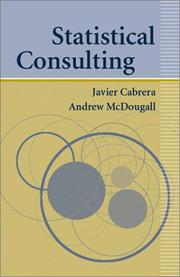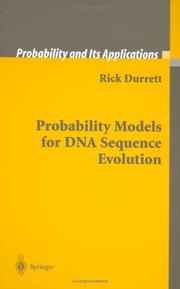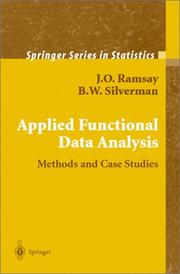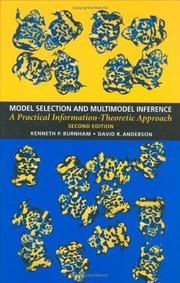| Listing 1 - 10 of 14 | << page >> |
Sort by
|

ISBN: 0387954023 9780387954028 0387954031 9786610009558 1280009551 0387224637 Year: 2002 Publisher: New York (N.Y.): Springer
Abstract | Keywords | Export | Availability | Bookmark
 Loading...
Loading...Choose an application
- Reference Manager
- EndNote
- RefWorks (Direct export to RefWorks)
Arguably the most intricate dynamic object in the universe, the human brain is an unsounded source of wonder for the scienti?c community. The primary aim of this book is to provide both students and established - vestigators in the growing area of neuroscience with an appreciation of the roles that mathematics may play in helping to understand this en- maticorgan. Alongwithdiscussionsofresultsobtainedbytheneuroscience community, emphasis is placed on suggesting fruitful research problems for those planning to embark on mathematical studies in neuroscience. To make the overall perspectives understandable to philosophers and psychologists, essential features of the discussions are presented in ordinary English, with more detailed mathematical comments in appendices and footnotes. Although it attempts to maintain both clarity and biological relevance, this is not a text on the anatomy of nerve systems; thus readers should bring some knowledge of neurophysiology through other courses, associated studies, or laboratory research. It is a guiding theme throughout the book that the brain is organized into several quite di?erent levels of dynamic activity. As will be seen, these levels are hierarchically structured, beginning with the molecular dynamics ofintrinsicmembraneproteinsandproceedingupward,throughtheswit- ing properties of active membrane patches and synapses, the emergence of impulses on active ?bers, overall properties of individual neurons, and the growth of functional assemblies of interacting neurons, to the global - namics of a brain. At each level of description, reality turns di?erent facets of her mystery to us, and diverse phenomena make their contributions to the brain’s collective behavior.
Physiology of nerves and sense organs --- Computer. Automation --- Mathematics --- #PBIB:2004.3 --- Neurosciences --- Mathematical models. --- Life sciences. --- Neurosciences. --- Neurobiology. --- Biomathematics. --- Statistics. --- Life Sciences. --- Statistics for Life Sciences, Medicine, Health Sciences. --- Mathematical and Computational Biology. --- Neural sciences --- Neurological sciences --- Neuroscience --- Medical sciences --- Nervous system --- Mathematical models --- Statistics . --- Biology --- Statistical analysis --- Statistical data --- Statistical methods --- Statistical science --- Econometrics

ISBN: 1280200863 9786610200863 0306475987 1402071116 Year: 2002 Publisher: New York, New York : Kluwer Academic Publishers,
Abstract | Keywords | Export | Availability | Bookmark
 Loading...
Loading...Choose an application
- Reference Manager
- EndNote
- RefWorks (Direct export to RefWorks)
Microarray technology is a major experimental tool for functional genomic explorations, and will continue to be a major tool throughout this decade and beyond. The recent explosion of this technology threatens to overwhelm the scientific community with massive quantities of data. Because microarray data analysis is an emerging field, very few analytical models currently exist. Methods of Microarray Data Analysis II is the second book in this pioneering series dedicated to this exciting new field. In a single reference, readers can learn about the most up-to-date methods, ranging from data normalization, feature selection, and discriminative analysis to machine learning techniques. Currently, there are no standard procedures for the design and analysis of microarray experiments. Methods of Microarray Data Analysis II focuses on a single data set, using a different method of analysis in each chapter. Real examples expose the strengths and weaknesses of each method for a given situation, aimed at helping readers choose appropriate protocols and utilize them for their own data set. In addition, web links are provided to the programs and tools discussed in several chapters. This book is an excellent reference not only for academic and industrial researchers, but also for core bioinformatics/genomics courses in undergraduate and graduate programs.
DNA microarrays --- DNA microarrays. --- Data processing --- Biochemistry. --- Human genetics. --- Statistics. --- Biochemistry, general. --- Human Genetics. --- Statistics for Life Sciences, Medicine, Health Sciences. --- Statistics . --- Statistical analysis --- Statistical data --- Statistical methods --- Statistical science --- Mathematics --- Econometrics --- Genetics --- Heredity, Human --- Human biology --- Physical anthropology --- Biological chemistry --- Chemical composition of organisms --- Organisms --- Physiological chemistry --- Biology --- Chemistry --- Medical sciences --- Composition --- DNA biochips --- Microarrays, DNA --- Biochips --- Immobilized nucleic acids

ISBN: 0387988637 1441931775 1475736630 9780387988634 Year: 2002 Publisher: New York (N.Y.): Springer
Abstract | Keywords | Export | Availability | Bookmark
 Loading...
Loading...Choose an application
- Reference Manager
- EndNote
- RefWorks (Direct export to RefWorks)
"Statistical Consulting" provides the reader with a detailed overview of the knowledge and communication skills that a statistician needs to be an effective consultant. The reference to "reader" is intentional since the aim of this book is to clearly illustrate what the consultant needs to know from the client--and why! For clients who need to seek the help of a statistical consultant, this book explains, in plain language, what is involved in the consulting process. This book is primarily written for the student or statistician who is interested in becoming involved in consulting activities. Different types of statistical consulting environments are discussed, followed by a detailed description of the communication skills that a statistician needs to develop to be an effective consultant. In describing the statistical methodology that a consultant can employ, the importance of engaging the client's understanding of the purpose and interpretation of a statistical procedure is emphasized. It is assumed that the reader has the necessary technical skills to apply the statistical methods used in this book. Part I of the book concludes with a consultation project reproduced in its entirety. A wide range of case studies of varying complexity are presented in Part II of the book that will help the reader understand and appreciate the diversity of projects that can arise in statistical consulting. The appendices provide valuable information on resources, details on the SAS and S-PLUS software packages, and a collection of useful reference tables. This book would also be a suitable text for a graduate course on statistical consulting and a course outline is provided for the instructor in Appendix A.
Mathematical statistics --- Statistical consultants --- Social sciences --- 519.2 --- #PBIB:2004.3 --- Consultants --- Statisticians --- Behavioral sciences --- Human sciences --- Sciences, Social --- Social science --- Social studies --- Civilization --- Probability. Mathematical statistics --- Statistical consultants. --- 519.2 Probability. Mathematical statistics --- Statistics . --- Statistical Theory and Methods. --- Statistics for Life Sciences, Medicine, Health Sciences. --- Statistics for Business, Management, Economics, Finance, Insurance. --- Statistics for Engineering, Physics, Computer Science, Chemistry and Earth Sciences. --- Statistics for Social Sciences, Humanities, Law. --- Statistical analysis --- Statistical data --- Statistical methods --- Statistical science --- Mathematics --- Econometrics

ISBN: 038795435X 1475762879 1475762852 Year: 2002 Publisher: New York : Springer,
Abstract | Keywords | Export | Availability | Bookmark
 Loading...
Loading...Choose an application
- Reference Manager
- EndNote
- RefWorks (Direct export to RefWorks)
How is genetic variability shaped by natural selection, demographic factors, and random genetic drift? To approach this question, we introduce and analyze a number of probability models beginning with the basics, and ending at the frontiers of current research. Throughout the book, the theory is developed in close connection with examples from the biology literature that illustrate the use of these results. Along the way, there are many numerical examples and graphs to illustrate the conclusions. This is the second edition and is twice the size of the first one. The material on recombination and the stepping stone model have been greatly expanded, there are many results form the last five years, and two new chapters on diffusion processes develop that viewpoint. This book is written for mathematicians and for biologists alike. No previous knowledge of concepts from biology is assumed, and only a basic knowledge of probability, including some familiarity with Markov chains and Poisson processes. The book has been restructured into a large number of subsections and written in a theorem-proof style, to more clearly highlight the main results and allow readers to find the results they need and to skip the proofs if they desire. Rick Durrett received his Ph.D. in operations research from Stanford University in 1976. He taught in the UCLA mathematics department before coming to Cornell in 1985. He is the author of eight books and 160 research papers, most of which concern the use of probability models in genetics and ecology. He is the academic father of 39 Ph.D. students and was recently elected to the National Academy of Science. .
Stochastic processes --- Mathematical statistics --- Genetics --- Nucleotide sequence --- Probabilities. --- Evolutionary genetics --- Variation (Biology) --- Génétique --- Séquence nucléotidique --- Probabilités --- Génétique évolutive --- Statistical methods. --- Méthodes statistiques --- Génétique --- Séquence nucléotidique --- Probabilités --- Génétique évolutive --- Méthodes statistiques --- Statistics . --- Biomathematics. --- Probability Theory and Stochastic Processes. --- Statistics for Life Sciences, Medicine, Health Sciences. --- Mathematical and Computational Biology. --- Biology --- Mathematics --- Statistical analysis --- Statistical data --- Statistical methods --- Statistical science --- Econometrics --- Probability --- Statistical inference --- Combinations --- Chance --- Least squares --- Risk

ISBN: 0387954147 9786610009572 1280009578 0387224653 9780387954141 Year: 2002 Publisher: New York Springer
Abstract | Keywords | Export | Availability | Bookmark
 Loading...
Loading...Choose an application
- Reference Manager
- EndNote
- RefWorks (Direct export to RefWorks)
Almost as soon as we had completed our previous book Functional Data Analysis in 1997, it became clear that potential interest in the field was far wider than the audience for the thematic presentation we had given there. At the same time, both of us rapidly became involved in relevant new research involving many colleagues in fields outside statistics. This book treats the field in a different way, by considering case stories arising from our own collaborative research to illustrate how functional data analysis ideas work out in practice in a diverse range of subject areas. These include criminology, economics, archaeology, rheumatology, psychology, neurophysiology, auxology (the study of human growth), meteorology, biomechanics, and education—and also a study of a juggling statistician. Obviously such an approach will not cover the field exhaustively, and in any case functional data analysis is not a hard-edged closed system of thought. Nevertheless we have tried to give a flavor of the range of methodology we ourselves have considered. We hope that our personal experience, including the fun we had working on these projects, will inspire others to extend “functional” thinking to many other statistical contexts. Of course, many of our case studies required development of existing methodology, and readers should gain the ability to adapt methods to their own problems too.
Multivariate analysis --- Mathematical statistics --- Statistics. --- Statistical Theory and Methods. --- Statistics for Social Science, Behavorial Science, Education, Public Policy, and Law. --- Statistics for Life Sciences, Medicine, Health Sciences. --- Statistics for Social Science, Behavioral Science, Education, Public Policy, and Law. --- Multivariate analysis. --- Mathematical statistics. --- Statistics for Social Sciences, Humanities, Law. --- Multivariate distributions --- Multivariate statistical analysis --- Statistical analysis, Multivariate --- Analysis of variance --- Matrices --- Statistics . --- Statistical analysis --- Statistical data --- Statistical methods --- Statistical science --- Mathematics --- Econometrics

ISBN: 0306483297 1402071108 0387336303 Year: 2002 Publisher: New York, NY : Springer US : Imprint: Springer,
Abstract | Keywords | Export | Availability | Bookmark
 Loading...
Loading...Choose an application
- Reference Manager
- EndNote
- RefWorks (Direct export to RefWorks)
The cross-disciplinary pursuits between modern technology, their computations and applications to the human body have exploded because of rapid developments in computer technology and mathematical computational techniques. This four-volume set, Computational Methods in Biophysics, Biomaterials, Biotechnology and Medical Systems, represents the first multi-volume treatment of this significant subject on the international scene. The work is an indispensable reference source by leading researchers, and is essential reference work for academics, practitioners, students and researchers working with: *Computers in Medicine, *Science and Mathematics in Biomaterials, Biomechanics and Bioengineering, *Computational Biophysics.
Engineering. --- Biomathematics. --- Statistics. --- Biomedical engineering. --- Materials science. --- Biomedical Engineering. --- Statistics for Life Sciences, Medicine, Health Sciences. --- Mathematical and Computational Biology. --- Characterization and Evaluation of Materials. --- Surfaces (Physics). --- Biomedical Engineering and Bioengineering. --- Physics --- Surface chemistry --- Surfaces (Technology) --- Statistical analysis --- Statistical data --- Statistical methods --- Statistical science --- Mathematics --- Econometrics --- Clinical engineering --- Medical engineering --- Bioengineering --- Biophysics --- Engineering --- Medicine --- Mathematics. --- Data processing. --- Computer simulation. --- Statistics . --- Material science --- Physical sciences --- Biology

ISBN: 0387953647 9786610009480 1280009489 0387224564 9780387953649 Year: 2002 Publisher: New York Springer
Abstract | Keywords | Export | Availability | Bookmark
 Loading...
Loading...Choose an application
- Reference Manager
- EndNote
- RefWorks (Direct export to RefWorks)
We wrote this book to introduce graduate students and research workers in various scienti?c disciplines to the use of information-theoretic approaches in the analysis of empirical data. These methods allow the data-based selection of a “best” model and a ranking and weighting of the remaining models in a pre-de?ned set. Traditional statistical inference can then be based on this selected best model. However, we now emphasize that information-theoretic approaches allow formal inference to be based on more than one model (m- timodel inference). Such procedures lead to more robust inferences in many cases, and we advocate these approaches throughout the book. The second edition was prepared with three goals in mind. First, we have tried to improve the presentation of the material. Boxes now highlight ess- tial expressions and points. Some reorganization has been done to improve the ?ow of concepts, and a new chapter has been added. Chapters 2 and 4 have been streamlined in view of the detailed theory provided in Chapter 7. S- ond, concepts related to making formal inferences from more than one model (multimodel inference) have been emphasized throughout the book, but p- ticularly in Chapters 4, 5, and 6. Third, new technical material has been added to Chapters 5 and 6. Well over 100 new references to the technical literature are given. These changes result primarily from our experiences while giving several seminars, workshops, and graduate courses on material in the ?rst e- tion.
Biology --- Mathematical statistics. --- Mathematical models. --- Biomathematics. Biometry. Biostatistics --- Mathematical statistics --- -#SBIB:303H61 --- 519.72 --- 519.72 Information theory: mathematical aspects --- Information theory: mathematical aspects --- Mathematics --- Statistical inference --- Statistics, Mathematical --- Statistics --- Probabilities --- Sampling (Statistics) --- Life sciences --- Biomass --- Life (Biology) --- Natural history --- Mathematical models --- Wiskundige methoden en technieken --- Statistical methods --- Biologie --- Statistique mathématique --- Modèles mathématiques --- EPUB-LIV-FT SPRINGER-B --- Statistics. --- Ecology. --- Statistical Theory and Methods. --- Statistics for Life Sciences, Medicine, Health Sciences. --- #SBIB:303H61 --- Biological models --- Biomathematics --- Statistics . --- Ecology . --- Balance of nature --- Bionomics --- Ecological processes --- Ecological science --- Ecological sciences --- Environment --- Environmental biology --- Oecology --- Environmental sciences --- Population biology --- Statistical analysis --- Statistical data --- Statistical science --- Econometrics --- Ecology --- Biology - Mathematical models.

ISBN: 038795340X 9786610187805 1280187808 0387216391 Year: 2002 Volume: 19 Publisher: New York, NY : Springer New York : Imprint: Springer,
Abstract | Keywords | Export | Availability | Bookmark
 Loading...
Loading...Choose an application
- Reference Manager
- EndNote
- RefWorks (Direct export to RefWorks)
This book provides a theoretical background of branching process and discusses their biological applications. Branching processes are a well-developed and powerful set of tools in the field of applied probability. The range of applications considered includes molecular biology, cellular biology, human evolution, and medicine. The branching processes discussed include Galton-Watson, Markov, Bellman-Harris, Multitype, and General Processes. As an aid to understanding specific examples, two introductory chapters and two glossaries are included that provide background material in mathematics and in biology. The book will be of interest to scientists who work in quantitative modeling of biological systems, particularly probabilists, mathematical biologists, biostatisticians, cell biologists, molecular biologists, and bioinformaticians. The authors are a mathematician and cell biologist who have collaborated for more than a decade in the field of branching processes in biology.
Biology --- Branching processes. --- Biologie --- Processus ramifiés --- Mathematical models. --- Modèles mathématiques --- EPUB-LIV-FT SPRINGER-B --- Branching processes --- Biomathematics. Biometry. Biostatistics --- Stochastic processes --- Distribution (Probability theory. --- Statistics. --- Bioinformatics. --- Cytology. --- Mathematical and Computational Biology. --- Probability Theory and Stochastic Processes. --- Statistics for Life Sciences, Medicine, Health Sciences. --- Cell Biology. --- Biomathematics. --- Probabilities. --- Statistics . --- Cell biology. --- Mathematics --- Bio-informatics --- Biological informatics --- Information science --- Computational biology --- Systems biology --- Cell biology --- Cellular biology --- Cells --- Statistical analysis --- Statistical data --- Statistical methods --- Statistical science --- Econometrics --- Probability --- Statistical inference --- Combinations --- Chance --- Least squares --- Mathematical statistics --- Risk --- Data processing

ISBN: 1280043652 9786610043651 0306469030 079238573X Year: 2002 Publisher: New York : Kluwer Academic Publishers,
Abstract | Keywords | Export | Availability | Bookmark
 Loading...
Loading...Choose an application
- Reference Manager
- EndNote
- RefWorks (Direct export to RefWorks)
Bioinformatics brings computational methods to the analysis and processing of genomic data. Bioinformatics: Databases and Systems focuses on the issues of system building and data curation that dominate the day-to-day concerns of bioinformatics practitioners. Included are chapters by many of today's leading bioinformatics practitioners, describing most of the current paradigms of system building and curation, including both their strengths and weaknesses. Biological topics covered include sequence databases, metabolic pathways, phenotypes, variety collections, gene expression atlases and neuroinformatics. Species range from bacteria to mammals to plants. Software systems and technologies covered include OPM, CORBA, SRS, KLEISLI, ACEDB, Web-based integration and laboratory workflow. Bioinformatics: Databases and Systems provides a valuable introduction for newcomers to the field, and a useful reference for veterans.
Bioinformatics. --- Biochemistry. --- Data structures (Computer scienc. --- Statistics. --- Pharmacy. --- Biochemistry, general. --- Data Structures and Information Theory. --- Statistics for Life Sciences, Medicine, Health Sciences. --- Data structures (Computer science). --- Statistics . --- Chemistry --- Medicine --- Drugs --- Materia medica --- Pharmacology --- Statistical analysis --- Statistical data --- Statistical methods --- Statistical science --- Mathematics --- Econometrics --- Information structures (Computer science) --- Structures, Data (Computer science) --- Structures, Information (Computer science) --- Electronic data processing --- File organization (Computer science) --- Abstract data types (Computer science) --- Biological chemistry --- Chemical composition of organisms --- Organisms --- Physiological chemistry --- Biology --- Medical sciences --- Composition --- Life sciences. --- Data structures (Computer science) --- Biosciences --- Sciences, Life --- Science

ISBN: 1402006381 9048160251 9401733813 9781402006388 Year: 2002 Volume: 11 Publisher: Dordrecht Kluwer
Abstract | Keywords | Export | Availability | Bookmark
 Loading...
Loading...Choose an application
- Reference Manager
- EndNote
- RefWorks (Direct export to RefWorks)
Guillaume Wunsch, Michel Mouchart, Josianne Duchene This book is an outcome of the activities of the Working Group on Health, Morbidity, and Mortality Differentials of the European Association for Population Studies, which was chaired for some years by one of the present editors (G. Wunsch). In collaboration with the Institute of Statistics and the Institute of Demography of the University of Louvain, this Working Group held a workshop in Louvain-Ia-Neuve a few years ago on the use of life tables in Europe, taking into account problems of data collection, methods, and models. Some of the participants in the workshop were then invited by the present editors to improve, develop, or in some cases thoroughly modify their papers in order to transform them into chapters of a book on life tables. Though life tables are one of the oldest tools in demography, and every textbook on demographic methods deals with the topic of life table construction, few books have dealt with the subject in depth. It is the hope of the editors that the present volume will fulfill to some extent this need. Though primarily written by and for demographers, this book will also be of use to actuaries working in life insurance, and to epidemiologists dealing with morbidity and cause of death. Furthermore, a topic such as competing risks theory should also be of interest to statisticians.
Demography --- Europe --- Mortality. --- Mortality --- Life expectancy. --- KBC0209-IVB --- 10.03.d --- Actuariaat ; (Sterfte)tafels --- Life expectancy --- Life tables --- Mortality tables --- Mortality, Law of --- Death --- Death (Biology) --- Expectancy of life --- Expectation of life --- Life spans (Biology) --- Vital statistics --- Premature death --- Demography. --- Population. --- Epidemiology. --- Business. --- Management science. --- Statistics . --- Public health. --- Population Economics. --- Business and Management, general. --- Statistics for Life Sciences, Medicine, Health Sciences. --- Public Health. --- Human population --- Human populations --- Population growth --- Populations, Human --- Economics --- Human ecology --- Sociology --- Malthusianism --- Historical demography --- Social sciences --- Population --- Diseases --- Public health --- Community health --- Health services --- Hygiene, Public --- Hygiene, Social --- Public health services --- Public hygiene --- Social hygiene --- Health --- Human services --- Biosecurity --- Health literacy --- Medicine, Preventive --- National health services --- Sanitation --- Statistical analysis --- Statistical data --- Statistical methods --- Statistical science --- Mathematics --- Econometrics --- Quantitative business analysis --- Management --- Problem solving --- Operations research --- Statistical decision --- Trade --- Commerce --- Industrial management --- Mortality - Tables.
| Listing 1 - 10 of 14 | << page >> |
Sort by
|

 Search
Search Feedback
Feedback About
About Help
Help News
News